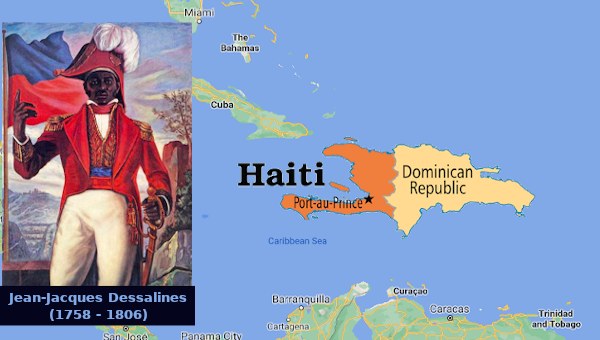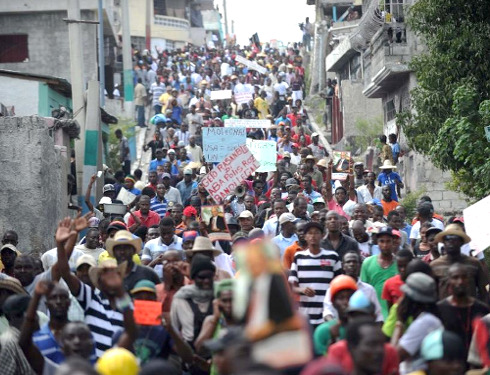Haiti’s Earthquake Victims in Peril
It’s been nearly eight weeks since the devastating earthquake in Haiti and familiar patterns of interference and neglect by the major powers that dominate the country are firmly entrenched. Notwithstanding heroic efforts of ordinary Haitian people, Haitian government officials and agencies, and many international organizations, a grave health risk hovers over the people residing in the earthquake zone or who have fled beyond it. Meanwhile, the direction of Haiti’s reconstruction remains entirely undetermined.
“Few events of such ferocity”
According to a February study by the Inter-American Development Bank, the cost of physical damage from Haiti’s earthquake ranges from $8-billion to $13-billion. It says, “there are few events of such ferocity as the Haiti 2010 earthquake.”
The study looks at natural disasters over the past 40 years and concludes that the death toll, per capita, of Haiti’s earthquake is four times or more higher than any other disaster in this time period. Nearly 24,000 people per million of Haiti’s population died. The total estimated death toll is well over 200,000. The closest equivalent is 4,000 per million, in the 1972 earthquake that struck Nicaragua.
 The Partners In Health agency estimates some 1.3 million people were left without shelter by the earthquake. The majority of those people still do not have adequate emergency shelter nor access to potable water, food and medical attention.
The Partners In Health agency estimates some 1.3 million people were left without shelter by the earthquake. The majority of those people still do not have adequate emergency shelter nor access to potable water, food and medical attention.
According to U.S. AID, there are approximately 600,000 displaced people living in 416 makeshift camps in Port-au-Prince. Sanitation conditions in the camps remain a grave concern. With heavy seasonal rains fast approaching, the population is extremely vulnerable to exposure and water-born disease.
The U.S. Centers for Disease Control and Prevention issued an alert on March 4 about another deadly danger that lurks: malaria. It said, “Displaced persons living outdoors or in temporary shelters and thousands of emergency responders in Haiti are at substantial risk for malaria.”
Each year, Haiti has 30,000 confirmed cases of malaria. Officials believe the actual number is closer to 200,000.
Partners In Health says it has established clinics in five of the makeshift settlements in Port-au-Prince, serving some 80,000 to 100,000 people.
A ‘broadly insufficient’ Relief Effort
Two leading directors of Doctors Without Borders have called the relief effort to date “broadly insufficient.” In a March 5 interview, they say that, “The lack of shelter and the hygiene conditions represent a danger not only in terms of public health, but they are also an intolerable breach of the human dignity of all these people.” They call conditions in the makeshift refugee camps where many survivors still struggle to survive “shocking” and “shameful.”
Partners In Health (PIH) voiced similar concerns in a March 5 press release and conference call. They called on governments and NGOs to do a better job addressing the “inhumane and rapidly deteriorating conditions on the ground in Haiti.”
PIH Executive Director Ophelia Dahl, recently returned from Haiti, told the conference call:
“We witnessed hundreds of thousands of people living in makeshift temporary shelters; spontaneous settlements made of scraps of cardboard and plastic bags. What little people have is soaked, because they’re sleeping in the rain, and the makeshift shelters are already breaking down and dissolving. The conditions for the homeless and displaced people are absolutely inhumane and getting worse every single day.”
‘We Are Issuing a Call to Action’
Under pressure from international agencies, the Haitian government has pulled back on its appeal for tent camps to be established to meet the displaced population’s needs. Since January, U.S. AID and some UN agencies have refused such calls, instead arguing for a policy that U.S. AID calls, “Thinking Outside the Tent.” Victims are directed to return to their shattered neighbourhoods and fend for themselves, albeit with promises of provision of building materials such as corrugated iron sheets for protection from the rains.
But those who have congregated into makeshift camps are there precisely because provision of aid to neighbourhoods has proven insufficient or entirely lacking.
Why the refusal to build large and secure camps? Could it be a fear that earthquake victims will be better placed to voice their concerns over the direction of the country? A Wall Street Journal article on March 8 reported, “Inside the many tent cities now home to hundreds of thousands of people, a rudimentary social order is beginning to emerge as committees agitate to secure food, water and supplies in high demand from international aid organizations.”
That’s the story of the Morne Lazarre neighbourhood in Petionville, a district on the outskirts of Port-au-Prince. There, the community school SOPUDEP has played a heroic role in organizing medical treatment and food and water supplies to the local population and even to other affected areas. School Director Réa Dol’s efforts are featured in a recent video documentary produced by the New York Times.
Conditions are also critical outside the earthquake zone. Cap Haitien, Haiti’s second largest city located 120 km north of Port-au-Prince, has received an estimated influx of 50,000 refugees. Its mayor, Michel St. Croix , recently told the Miami Herald, “We need housing, sanitation, security — we need everything.” He said the city has received next to no assistance from the United Nations nor the International Red Cross.
‘Rebuild Haiti’
PIH is calling for more international support to the ministries and agencies of the Haitian government. Chief Program Officer Ted Constan told its March 5 conference call:
“Of the aid money coming into Haiti, the Haitian government is seeing a very small amount – about $1 of every $100.
“The government of Haiti is standing up on its feet: staff are returning to the General Hospital, they are running vaccination camps, they are running registration drives for displaced people, they are maintaining and strengthening their presence at the airport. We need to make sure aid money is used to capacitate and hold accountable the government of Haiti – it’s the only real solution to these challenges over the long term.”
Constan spoke of the “sad fact” that the Haitian Ministry of Health does not even have vehicles in which to move around.
President Rene Préval arrived in Washington on March 8 for several days of talks as the U.S. Congress prepared to vote on further aid spending in Haiti. He told reporters in Miami while en route, “What’s most important is the philosophy of the reconstruction. It’s not just ‘reconstruct Port-au-Prince.’ It’s ‘rebuild Haiti’.”
Decades of neglect of the provinces and agriculture, Préval said, have forced people into the overcrowded capital city. This economic migration must be turned around, he argues. “We need to put jobs in the provinces, and for that you need roads, electricity, education, health.”
In an interview with Associated Press on March 5, Haiti’s Prime Minister Jean-Max Bellerive repeated his government’s growing concern with the international aid effort. “Too many people are raising money without any controls, and don’t explain what they’re doing with it.”
Préval says the direction of international aid is becoming a barrier to the creation of government institutions and of economic activity that could gradually supply more and more of the country’s needs.
Every foreign government in Haiti pays lip service to the principle of strengthening the capacities of the Haitian government, its ministries and agencies. But most have failed that test. In a speech by PIH founder Paul Farmer to a conference of GlobeMed in Chicago on March 5, he said a recent study of financial promises made to Haiti at a UN donors conference in April 2009 showed that of the more than $400-million aid dollars promised, only fifteen percent was delivered by the time of the earthquake.
Farmer warned against the “trauma vultures” descending on Haiti. He asked why so many years of aid and charitable funds going to Haiti has left the country poorer than ever.
Mark Turner, a spokesman with the International Organization for Migration, voiced concerns over aid to the Miami Herald on March 9. “Many people have got very profound motivations for doing this work,” he said. “But organizationally, the aid industry is like corporations. A budget depends on a big job that is high profile, and if you want budget, you want staff, you have to be here.”
The record of international donors will again be put to the test when a UN-organized donors conference convenes in New York City on March 31.
Canadian Government and Media
Silent on the Looming Dangers
If some relief agencies are voicing concern about the relief effort, it’s being largely ignored in Canada. Haiti’s desperate plight has fallen off the radar of Canada’s media.
Minister of Foreign Affairs Peter Mackay visited Haiti on March 6 and 7 and he gave a glowing report on Canada’s relief work. He told CBC Radio news, “Canada’s contribution in Haiti was among the quickest and has had the most impact.”
Canada was one of the few large countries in the world that did not send civilian emergency rescue teams to Haiti. Its official aid mission arrived one week after the earthquake in the form of two warships and 2,000 military personnel. They pitched into the relief effort and earned praise for their work. But most of the assistance brought by the military, including its field hospital in Léogâne and its emergency health center in Jacmel, have now been withdrawn.
Deep Hundal, a student in Vancouver who volunteered in the earthquake zone area where the Canadian military was present says the needs in Haiti will go on for years. He explains, “The Canadian military is not a relief agency. It helped out with short-term needs. Aid and reconstruction is a long-term process. Who is going to pick up where the military’s work left off?”
Speaking in Parliament on March 11 on the government’s response to the earthquake, Prime Minister Stephen Harper declared, “Ships of the Atlantic fleet were immediately ordered to Haiti from Halifax, loaded with relief supplies.”
A report in the Halifax Chronicle Herald the following day refuted Harper’s claim. HMCS Halifax and HMCS Athabasca, in fact, carried precious little supplies beyond the needs of their crew and the additional military personnel they carried. And herein lies a clue to the thinking and planning of Canadian political and military leaders.
Like their U.S. counterparts, the first response of Canada’s leaders was concern and preoccupation that the earthquake disaster would open space for the Haitian people to retake some of the sovereign political ground lost following the overthrow of their elected government in 2004. The first actions of all the foreign militaries dispatched to Haiti was to flood the earthquake zone with heavily armed patrols and to otherwise ensure the “security” of the respective cities where they were assigned. The U.S. demanded and received complete control over the national airport in Port-au-Prince.
Hope for Haiti in Latin America
A different kind of aid was offered to Haiti by the people and governments of Cuba and Venezuela. This was the subject of a public forum in Vancouver on March 5 titled “Hope for Haiti in Latin America.”
Speaking on a panel that included Professor Jon Beasley-Murray of the University of British Columbia and Larry Keuhn of the BC Teachers Federation, writer and author Federico Fuentes from Venezuela detailed that country’s response to the crisis. It landed teams of aid and medical workers within hours of the earthquake and quickly assisted in erecting shelter. It has cancelled Haiti’s outstanding debt to Venezuela and is providing free fuel during the reconstruction process.
Prior to the earthquake, Cuba had some 350 health professionals volunteering in Haiti. That number, including graduates and students from the Latin American Medical School (ELAM) in Cuba, has expanded considerably.
Since 2005, 550 Haitian doctors have graduated from ELAM. The school received its first Haitian students in 1999. Currently, there are 570 students from Haiti attending the school.
Fuentes commented to the forum, “The ALBA economic and social agreement among nine countries of Latin America and the Caribbean shows a different path of development for Haiti than the one imposed on it for years and decades by the United States and its allies. Among ALBA member countries, economic and social exchanges are based on principles of equality and solidarity.” •
An important source of news and analysis on Haiti is the new website Haiti Relief and Reconstruction Watch. Much information in this article was obtained from sources it cited. Timely and informative articles and videos are also posted to the website of the Canada Haiti Action Network and the Institute for Justice and Democracy in Haiti.





